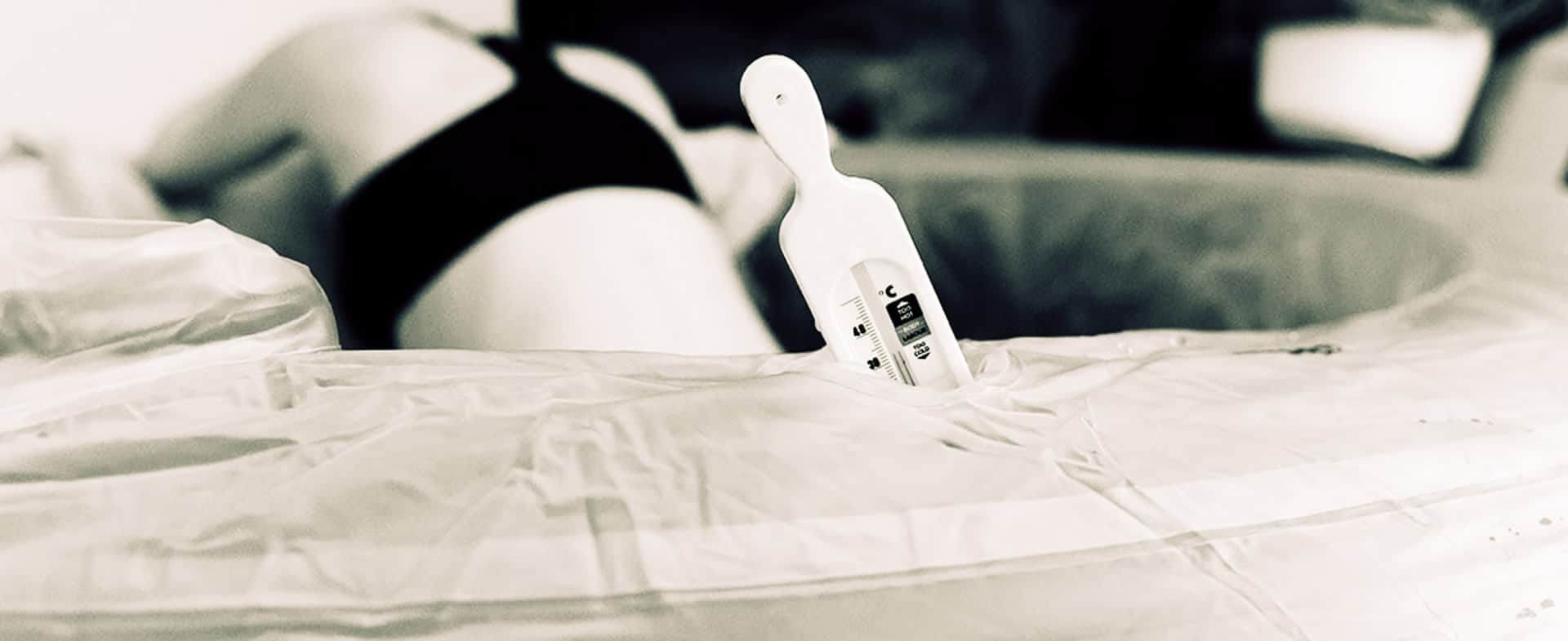
Water birth is the process of giving birth in a birth pool filled with warm water. Water births are done in a birth pool. When the first stage of labour starts, your partner can set up the birth pool. Below, you will read more about the different stages of a water birth.
During the first stage of labour you can enter the pool. The warm water of the birth pool has an analgesic effect and allows for a more relaxing and soothing birth experience. Stronger contractions often start after 4 cm dilation. Your body will produce pain inhibitors – endorphins – that complement labour and decrease pain. A water birth in our birth pool allows optimal mobility and the feeling of being weightless, which encourages dilation.
After 90 minutes in the warm water, hormonally, your body will have experienced the peak of pain alleviation. Therefore, you might want to step out of the pool. Your bladder can then be emptied and your midwife can perform an internal exam.
Your midwife can also check and monitor you and your baby while you are in the water. Your midwife can use her Doppler to check on the baby’s heartbeat. For a water birth in the hospital, your nurse or doctor can attach a wireless CTG to your belly.
Internal exams can also be performed in the water to determine progression of your dilation. Sometimes the pelvis will need to be turned forward to provide easier access for the midwife.
During the second stage of labour, when you are fully dilated and your baby is moving through the birth canal, you can remain in the birth pool. While you remain in the water, your midwife can check after a few pushed whether you made any progress and are fully dilated. During this stage, your midwife will check your baby’s heartbeat after every contraction.
Healthcare providers are more reserved with catching the baby during birth. Since healthcare provides/midwives are generally more reserved catching the baby during a water birth than during a land birth, the head of the baby is usually delivered after the first contraction, and the body of the baby with the following contractions. The midwife, the mother, or the father/partner can catch the baby under water and slowly emerge it out of the water.
The transition from the warm water to the colder air will be gradual, and as such, water babies have a calmer entry into the world. Although many water babies don’t scream or cry hard when born, the baby’s lungs still fully expand and develop during their water birth.
Depending on the wishes of the mother and the condition of the baby, the baby can remain for a maximum of 30 seconds under water before it is emerged from the water. Through experience we know that mothers want to place their infant on their chest soon after birthing. Once the baby is emerged from the water, the infant cannot be submerged again since it will have taken its first breath.
The mother can use the seat in the birth pool to ensure that the baby remains above water. The baby can be covered with blankets to keep it warm and can be given a cap. The blankets can be kept warm with the warm water in the birth pool.
The healthcare provider will indicate when the umbilical cord can be cut. This can be done once the umbilical cord is done pulsing. In addition, the healthcare provider will determine the amount of blood loss for the mother and check regularly the position of the placenta.
The placenta can also be delivered under water. Depending on the wishes of the mother, the midwife, and the amount of blood loss the placenta can be delivered in the birth pool or outside the birth pool.
Depending on the condition of the mother, the baby, and the amount of blood loss, the midwife will advise to exit the pool. This is different for each person, but often a mother and baby will not remain in the birth pool for longer than 15 minutes after delivery of the infant.
After the birth of her baby, the mother will exit the birth pool and be dried off. She can then recover in her bed with her baby on her chest skin-to-skin. It is important that both mother and baby are warmly covered in blankets to ensure adequate warmth and comfort.
After the birth of the baby, while the mother and baby are resting and recovering, the partner (and potentially a caregiver on hand), can clean the birth pool and fold and store it for pick-up.
In big strokes, this is the process of water birth. Would you like to know more about the advantages of a water birth and where it is possible? Please consult the information below: